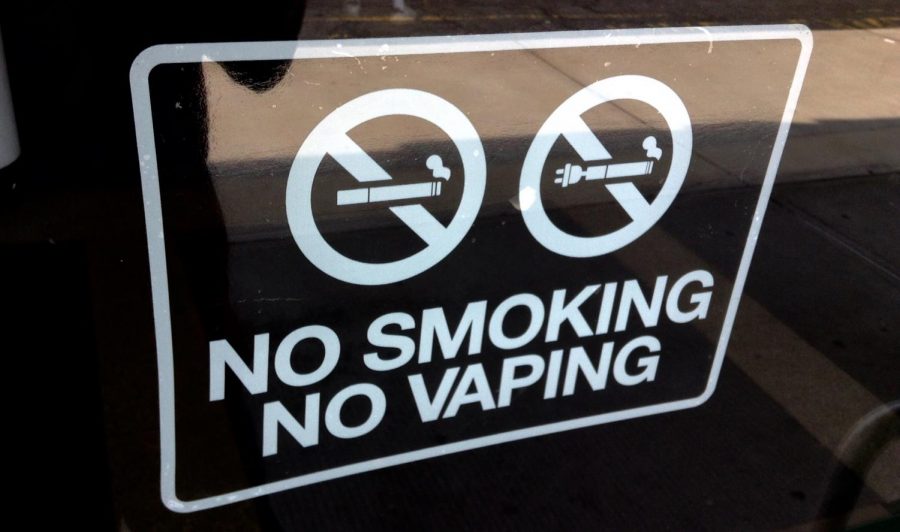Congress’ Measures to Combat Nicotine Use: Another Prohibition?
The popularity of nicotine products among teenagers is an issue. It plagues the news daily, and personal stories from individuals who have fallen ill due to the drug are scattered across Instagram feeds and Facebook pages. Children have been forewarned of the danger of smoking. Countless assemblies in elementary school and projects in health class taught our generation the adverse effects of this harmful habit. For a while, it seemed as though the message was getting through. The sight of a teenager smoking a cigarette is relatively rare these days, especially compared to the prevalence of smoking amongst older generations.
Nonetheless, these precautionary measures derailed once vaping consumed the nation. It quickly grew in recognition among younger generations, and, honestly, the movement is not very surprising. The ingenuity of the product lies in its marketability. Teens saw JUULs as a safer alternative to cigarettes since these products eradicated the use of tobacco.
Furthermore, such brands as JUUL took care not to have the same associations as e-cigarettes, which are usually seen as devices intended to aid people in weaning off cigarettes. Instead, vaping devices were produced in a completely new shape, with virtually no reference to the typical look of a cigarette. Also, a wide array of vape juice flavors were released in an attempt to appeal to younger generations, although companies tend to claim innocence to this knowledge. However, I find it difficult to believe that the implementation of fruit-flavored vape juice would sway most adults who grew up smoking cigarettes.
However, vaping is not the “safe alternative” to smoking that companies proclaim it to be. Most vape juice products contain nicotine, which is an extremely addictive drug in and of itself.
The most disgusting part of this phenomenon is that nicotine is genuinely not necessary for the creation of vape juice. It is entirely plausible for the product to contain no nicotine. That is how the product begins before nicotine is subsequently added. There is nothing like relying on children to develop addictions to keep your business flourishing.
Thankfully, the United States government is beginning to take notice of this issue. Congress recently passed a new law raising the age limits for purchasing cigarettes, tobacco products, and other vaping products containing nicotine. The minimum age has now been pushed from 18 to 21 across the United States; this is an apparent first step taken by Congress to attempt to combat the vaping revolution.
However, these moves are not enough. Over time, these measures will prove themselves to be inefficient. The problem is not in the law itself, but in the lack of enforcement of these laws. Vaping stores continue to pop up across the nation, and these businesses are profiting off the addiction of children. These laws have proved themselves to be ineffective time and time again.
When the age limit was 18, vaping was still extremely prevalent with high school students. Children would sit on the school bus, smell cotton candy and intuitively know that it was the kids vaping on their way home from school. These kids were not all 18 or above. There are a plethora of loopholes to the rule.
It was easy enough for high schoolers to find an 18-year-old “middleman” to buy vape juice legally and sell it to their younger friends at a markup. Price proponents of the increased age limit argue that it will erase this practice undoubtedly since younger kids will no longer be able to find 18 year olds to purchase the drug for them. This argument is extremely weak. If anything, these 18-year-old kids will have to convince their 21-year-old friends to buy the products, and the chain of sale will just become even more convoluted.
An easy way to think of how the law will ultimately fail is to compare the illegal sale of vaping products to the unlawful sale of alcohol. Back in the 80s, the age limit for purchasing alcohol was raised from 18 to 21 in a very similar fashion. Today, the effects of the law are incredibly minimal. First-year students in high school can still manage to find a way to get their hands on alcohol, and the same will go for those in search of vaping products.
While the intent of the government is certainly admirable, its tactics are insufficient. Congress has seemingly identified the issue of the legality of vaping products to lie in the weakness of the law when, in reality, the actual problem is in the lack of enforcement in the law. More preventative steps need to be taken in a child’s formative years to instill the next generation with the same distaste our generation has for cigarettes, as we should for vaping products.
Taylor Herzlich, GSB ’23, is a business administration major from Mount Sinai, New York.

Taylor Herzlich is a senior at Fordham College at Rose Hill. She is majoring in journalism with a minor in English. Taylor started writing for the Ram...










































































































































































































